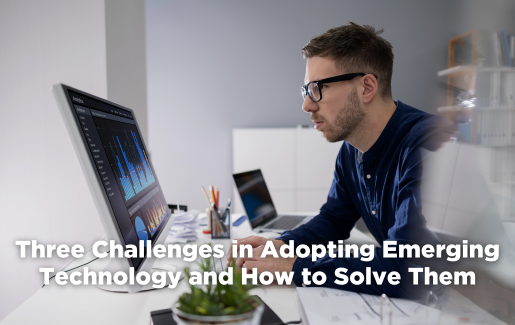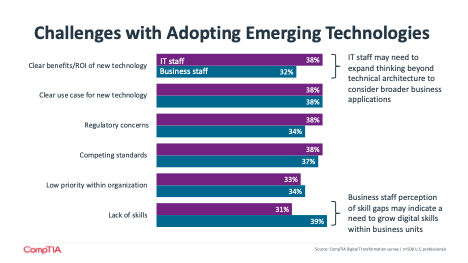 A few years ago, back before the pandemic disrupted business in a big way, another topic kicked off a more subtle wave of disruption. People started talking about “emerging technology,” treating this broad term as a new field of IT that would require specialized focus and drive distinctive results.
A few years ago, back before the pandemic disrupted business in a big way, another topic kicked off a more subtle wave of disruption. People started talking about “emerging technology,” treating this broad term as a new field of IT that would require specialized focus and drive distinctive results.
Over time, the original view of emerging technology has shown some flaws. The biggest misstep has been thinking about either the broad category of emerging technology or any of the individual parts as standalone pieces. CompTIA’s whitepaper on The Role of Emerging Technology in Digital Transformation explores the nature of emerging technologies as enabling rather than primary solutions. We’ve seen a lot of struggles in understanding the way that emerging technologies fit into businesses, and most of those struggles are tied back to understanding this difference.
At the same time, there is still some value in building an approach to emerging technology as a general concept. If emerging technologies are enabling, then they will get integrated into tech workflows in a variety of different ways. And if they are emerging, then by definition that integration requires a novel approach. In our recent research on digital transformation, we uncovered several challenges companies are facing when trying to adopt emerging technology. Here are three of the biggest, with some ideas on how to tackle them.

The Where and the Why
At the top of the list, the first two challenges can be taken together as parts of the same problem. Organizations are clearly struggling with where emerging technology can be used and why the new technology is worth the investment. Building the use case is the place where the enabling mindset comes into play; most use cases will highlight emerging technology as part of a larger solution. Figuring out the benefits requires a solid understanding of business objectives, in order to describe how an investment will have a return that drives success.
For IT pros leading the discussions around emerging technology within their organization, the main idea is to think beyond the specific technology. Knowing exactly how artificial intelligence (AI) is trained or how blockchain maintains consistency is important, but it’s also important to know how AI improves cybersecurity analysis or how blockchain accelerates a contract process. Describing new capabilities inside existing business applications and providing a metric for success is one big step toward seamless adoption.
The Who
A second set of challenges revolves around who might impact the way the technology is used. Specifically, we’re talking about people on the outside. Whether it’s government regulations that dictate digital operations or standards coming from industry groups that define interoperability, there’s an ecosystem of players that shape the evolution of emerging trends.
Staying connected is a critical step to help address this complex situation. Whether it’s through professional networking groups, continuing education or self-study, being aware of ongoing developments will allow IT pros to help their organizations navigate external factors. As technology begins to be more established, certifications are a top tool for learning best practices in regulatory compliance and current information for technology standards.
The How
Finally, there is the question of how the technology will be implemented. This, of course, is a question of skills. Since emerging technologies are usually enabling technologies, there are two layers of skill involved: The foundational skill in the main application or solution and the extended skill in the emerging technology.
Constantly building skills is a familiar practice for most IT professionals. The challenge in today’s environment is finding the balance between depth and breadth. Deep technical skill in a given area is typically the way to advance toward expert-level job roles, but the complexity of today’s landscape demands some degree of breadth to understand system-level interactions. A solid training and certification plan can address both depth and breadth depending on the appetite of the individual.
Emerging technology has been a bit of a mystery, mostly because it’s part of a massive paradigm shift from tactical IT to strategic IT. But it doesn’t have to remain a mystery. By developing skills and practices around the modern application of technology, IT pros can clear the roadblocks standing in the way of emerging technology adoption.
CompTIA is here to support you throughout your IT career. Get free resources, career advice, and special offers on CompTIA training and certifications!

